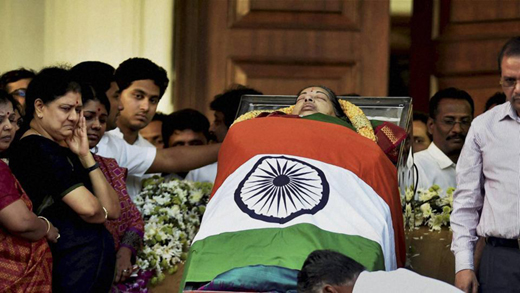Jayalalithaa was suffering from infection that led to organ failure: doctors
Mangalore Today News Network
New Delhi, Feb 06, 2017: A team of senior doctors attempted on Monday to quell swirling rumours surrounding former Tamil Nadu chief minister J Jayalalithaa’s death, saying the AIADMK leader was given the best possible treatment and even intermittently conscious for days during her prolonged hospitalisation.

London-based specialist Richard Beale told reporters in Chennai that Jayalalithaa had sepsis when she was brought into Apollo Hospital last September in a conscious state the source of infection was unknown.
The infection had led to severe organ damage, which combined with her chronic diabetes and hypertension, had caused deterioration in Jayalalithaa’s health.
“The process of treatment was straightforward. There was no conspiracy,” Beale said, adding that any questions of exhuming the body were “ridiculous”.
Beale said he met Sasikala Natarajan – Jayalalithaa’s confidante for more than 30 years – on a number of occasions. Sasikala is tipped to be the next CM of the state.
“Sasikala was present much of the time and was closely engaged in the care in supportive manner,” Beale said.
Jayalalithaa’s death on December 5 – which saw millions of her followers throng her funeral in grief – has returned to the headlines recently following allegations that she wasn’t given proper treatment, which was couched in unusual secrecy.
“It was a completely unexpected cardiac arrest…why? We don’t know. For someone in their more mature years, hypertension and diabetes, recovering sepsis may have contributed,” said Beale, who had been flown in from London for the treatment.
Beale was flanked by P Balaji of Madras Medical College and K Babu of Apollo Hospitals, who had signed in election forms on which her thumb impression was taken.
Balaji said the former CM was fully conscious when she put her thumb impression on the poll papers.
“She was talking, eating, interacting with officials for about a week… her sepsis made her tired, her breathing was getting worse… she was put on a ventilator and sleeping medicines…for 10 days she wasn’t able to communicate continuously…but she did so by signs…after we conducted a tracheostomy, she was awake for 10-12 days awake and communicating by sign and lip reading,” said Balaji.
“She was completely aware and interacting for days,” said Beale. He added that there no questions of releasing photographs of Jayalalithaa arose because it would breach privacy and confidentiality. No CCTV footage existed, he added.
The doctors said she intermittently talked to the medical staff about what she liked to watch on TV, food and her rehabilitation.
“At a personal level, it was clear to me what a most remarkable lady she was. It was a privilege to be involved in her care. I could sense her dedication,” said Beale
She was eating curd rice and watching television when she suffered the “unexpected” cardiac arrest which was witnessed, doctors said. “She was given CPR for 20 minutes but when it failed, she was put on extracorporeal membrane oxygenation for 24 hours. It was then we realised that continuing care was futile. It was relayed to senior government officials and family,” Balaji said.
- JEE Mains: Six Expert PU College Students Score 100 Percentile in Individual Subjects
- Govt Will Not Rush Caste Census Decision: D.K. Shivakumar
- 18-Year-Old Girl Goes Missing in Mangaluru
- Bantwal Rural Police Crack Cloth Shop Theft Case in Farangipete
- Deputy CM DK Shivakumar Offers Prayers at Dharmashala Temple
- Sharpshooter Suspected in Ricky Rai Attack, Police Probe Rivalries
- Video of Five Riding a Scooter Sparks Outrage in Manipal
- Thumbe Dam Reaches Full Capacity, Ensures 40 Days of Water Supply for Mangaluru
- Three Sentenced to Triple Life Imprisonment in 2014 Mangaluru Double Murder Case
- Palimar Seer condemn denial of CET entry over ’Janivara’; Demand retest for affected student
- Case Filed Against Three for Blocking Traffic during protest against Waqf Amendment Act in Adyar
- Mangaluru: Commissioner denies misuse of police vehicle during Waqf protest, cites medical emergency
- Belthangady: Autorickshaw overturns near Ujire; driver seriously injured
- Opposition Slams BJP MPs’ Criticism of Supreme Court; BJP Distances Itself
- Honour to speak with PM Modi, will visit India later this year: Elon Musk
- India tears into Yunus regime over Hindu leader’s killing in Bangladesh
- Two homeguards suspended for asking students to remove sacred thread at Shivamogga college
- Caste census report politically motivated, says R Ashoka
- PM Modi to visit Saudi Arabia from April 22-23
- 4 dead, many feared trapped as building collapses in Delhi’s Mustafabad
- Kerala teacher acquitted as student confesses fake rape allegation
- CET officials booked for asking students to remove sacred thread at exam centre in Shivamogga
- BJP worker found hanging in Bengaluru outskirts, video message names ‘local leader’
- CET row: Karnataka govt orders probe after students asked to remove sacred thread
- Man who flashed woman, assaulted 7 people arrested in Bengaluru
- Skills and Competencies Take Center Stage at MSN Dialogue Series
- Court remands Maoist Lakshmi to six-day police custody
- Sandhya Shenoy honored with Society for Materials Chemistry Medal-2024
- White Cornus Apartment in Mangaluru
- City girl wins first place in state-level spell bee competition
- Alleged ‘Love Jihad’ Case in Mangaluru: Woman left home voluntarily, says police
- Girl fatally struck by reckless two-wheeler near Belman
- New residential complex for the judges inaugurated in Mangaluru
- Absconding accused nabbed after 8 years
- Truck with cylinders turns turtle in Beltangady
- Bhoota Kola artist dies of cardiac arrest
- Development of the country should be our goal: Ganesh Karnik
- Container truck gets stuck under Modankap railway bridge
- Truck crushes bike’s pillion rider near BC Road
- Head constable dies of heart attack
- CITY INFORMATION
- TRAVEL
- TOURIST INFORMATION
- HEALTH CARE
- MISCELLANEOUS




 Write Comment
Write Comment E-Mail To a Friend
E-Mail To a Friend Facebook
Facebook Twitter
Twitter  Print
Print 


